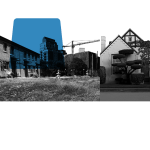"Can we do that?” When a local government sets out to solve a local problem, it must always begin with this baseline question about its power and resources.
So it is with housing and health. Leaders and constituents in a community might advocate a number of proposals to address the health problems caused by scarce, insecure, or deteriorated housing, but not all of these proposals will be legally permissible or fiscally feasible. Any local government considering a plan to address housing shortages or conditions must pass through three stages of analysis.
1) Does the city have sufficient power to act?
State statues and constitutions give local governments their power. This grant of authority can be broad, as in so-called“home rule” states with stronger traditions of local autonomy, or it can be narrow. State law can allow broad experimentation with local laws and programs that try to address local problems, or it can strictly limit local action to policies favored by the state.
There are strong arguments to keep housing policy questions at the local level. Housing regulations, after all, are a species of land use control. Land use is a traditional bedrock of local power, in part because local needs and policy preferences will vary widely among communities.
For instance, local leaders may wish to amend a city or county’s regulations related to housing availability, stabilization, and habitability. They may wish to protect tenants from rising housing costs, change processes for evictions, require affordable housing investment by developers, or establish new housing safety laws.
Local solutions can match the local context. A city with an overheated housing market, like Oakland, may well favor rent stabilization measures that would not be advisable or politically popular in a city with a weaker market, like Stockton. Any given city should also preserve flexibility, allowing it to adapt to changing conditions. But state laws will vary in what kinds of reforms are permissible.
The BLOCK project has been working with three innovative partners in three states (California, Colorado, and Maryland). At these sites, the role of state law and preemption illustrate how local power to address housing can be constrained or enhanced. In Colorado, a state law enacted in 1981 forbids rent control, and that prohibition has been interpreted broadly by the state supreme court to block local inclusionary zoning laws as well [1]. In California and Maryland, by contrast, local governments may enact rent control laws (as well as inclusionary zoning programs), though they must do so within the constraints of a state statute. Maryland is the only state in the country that has adopted an all-payer system for hospital health care, which creates unique possibilities for health and housing policies.
In cases where state law is ambiguous about whether a particular regulation is permitted, advocates can apply pressure locally to encourage their government to take a calculated risk to assert their power. If a regulation is clearly prohibited by state law (whether by unambiguous statutory text, court decisions, or the state constitution), the bar moves much higher, because advocates would need a successful campaign to reform state law. This usually requires concerted advocacy and public pressure. Sometime, as recently happened in Oregon, changes in the local markets help push states to reform laws, providing more flexibility for local government.
Generally speaking , it is increasingly true that cities populated by broke people have broke governments. In turn, broke governments have fewer tools to improve living conditions for the local poor.
2) Does the city have enough money for this?
Even where a city or county has authority to act, there will be fiscal limits on what it can afford to do. Many cities would like to increase their direct investment in subsidizing the construction or rehabilitation of affordable housing. Just about any local government would love to improve the local services that wrap housing with safe, healthy neighborhoods (such as parks, better transit, public safety improvements, and the like). But we are now decades into an anti-tax revolution that has set strict controls on state and local governments’ ability to raise public revenues through taxes and fees. These changes have reduced what local governments can raise locally, but also the funds that they receive through state appropriations. Generally speaking , it is increasingly true that cities populated by broke people have broke governments. In turn, broke governments have fewer tools to improve living conditions for the local poor.
These constraints mean that local residents must become more active at trying to influence their public budget and recognizing the difficult trade-offs their officials face. They could lead a campaign to approve a special tax at the ballot box. They could lobby to shift resources away from one expenditure and toward another. They could look to the state level, to advocate for increased appropriations to local governments serving poor communities.
Having money without political will is a tricky problem, but it may be preferable to having political will without money.
3) Does the city have political will to take this step?
Of course, authority and money don’t move law unless political will drives leaders to use them. Indeed, some of our most overheated housing markets (including in Alameda County and in Denver) have growing tax bases alongside a desperate shortage of affordable housing. In theory, the rising market creates a chance to increase investment and experimentation in housing and health. On the other hand, the influx of wealth may weaken the local political base that supports affordable housing measures. Having money without political will is a tricky problem, but it may be preferable to having political will without money. That is the situation in a city like Baltimore, where there is strong political support for improving housing and neighborhood conditions, but the sagging tax base and high local need make it hard to fund those preferences without increasing state aid. The contrast between what people need and what they can afford may well explain why poor cities counterintuitively spend much less on redistribution than wealthier ones.[2]
Answering the question “What can we do?” is a necessary first step for local governments trying to address the housing needs in their community. The key to effective social movements, however, is not to take the answer to that question as if it were set in stone. Local power — like any government authority — can be changed. It can be used for good or for ill. It can alleviate poverty, or ignore it; it can protect poor people from unsafe housing, or bar them from finding any housing. In that sense, the more important question is “What will we do?”
[1] See Colo. Rev. Stat. § 38–12–301; Town of Telluride v. Lot Thirty Four Venture, 3 P.3d 30 (Colo. 2000).
[2] A major national study of city spending patterns found that cities with lower total revenue per capita increased spending on efforts to spark economic growth and decreased spending related to redistribution (a category that includes not just housing, but also education, public health, and welfare spending). See Zoltan L. Hajnal & Jessica Trounstine, Who or What Governs?: The Effects of Economics, Politics, Institutions, and Needs on Local Spending, 38 AM. POL. RES. 1130, 1148 tbl.2., 1152 (2010).
Michelle Wilde Anderson is a scholar of state and local governance law. She is a Professor of Law at Stanford Law School, and the Robert E. Paradise Faculty Fellow for Excellence in Teaching and Research.

